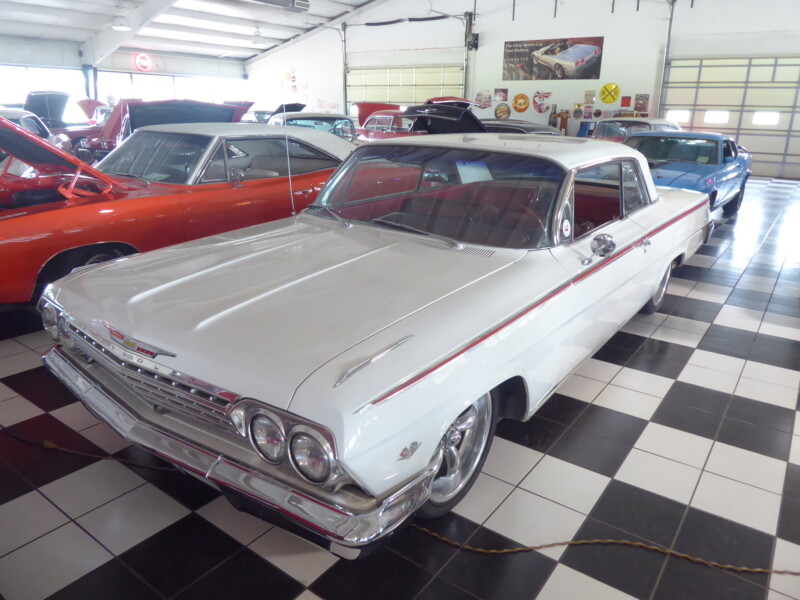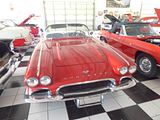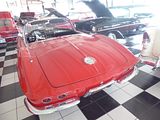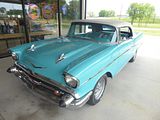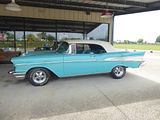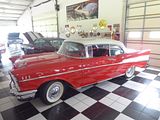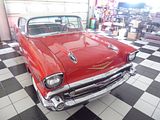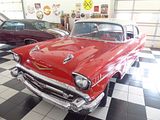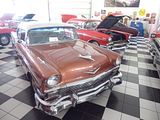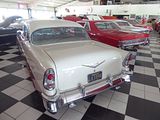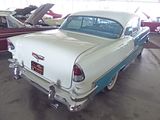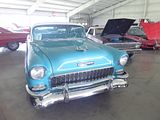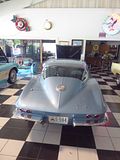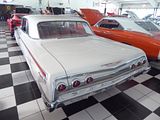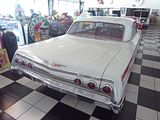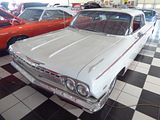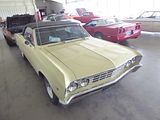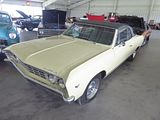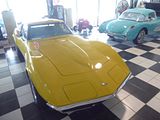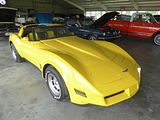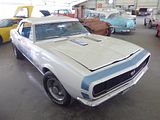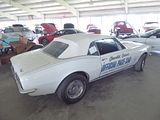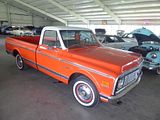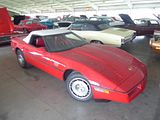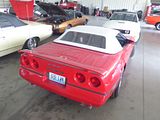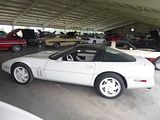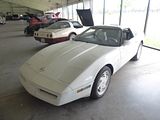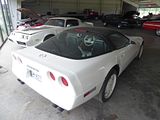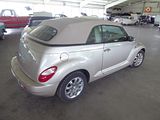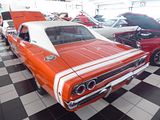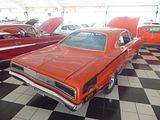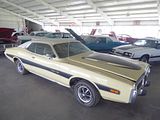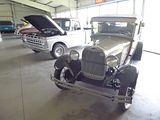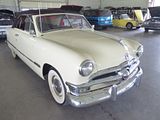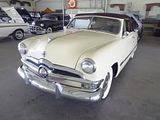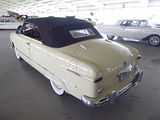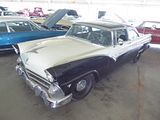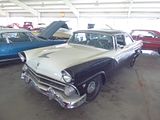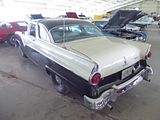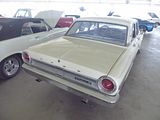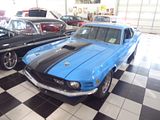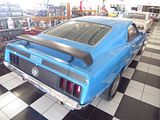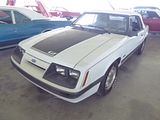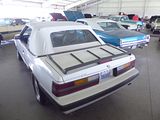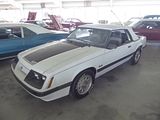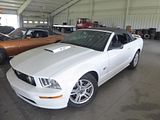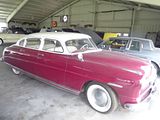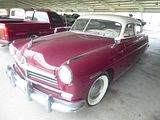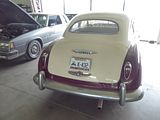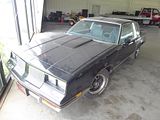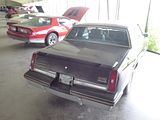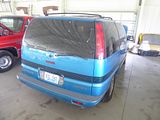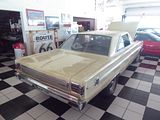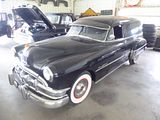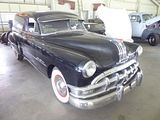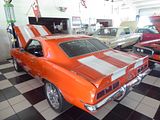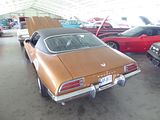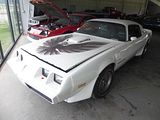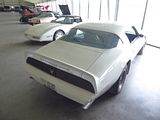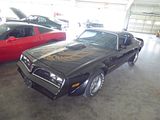Wandering around the outside of the National Corvette Museum, looking at the various cars that were in the parking lot, I spotted to one side a few classic cars parked outside a building which on closer inspection appeared to be full of other classics. A large sign read “Art’s Vettes and Auto Mart”. I had to go over and take a closer look. Sure enough, this is a classic car dealer and there was a long “showroom” which appeared to be full of old American cars. Luckily, the place was open, so I went in and found a sort of reception desk amid all manner of stuff ranging from models to accessories. It turned out that entrance cost $10.00, cash only, but with a long showroom of cars enticing me, I did not hesitate to pay up, and headed into the first of two large halls which are a sort of mix of showroom, workshop and storage facility. There are well over 100 cars here, but they were in a very varied state from pristine to neglected, with any having more than one flat tyre. Prices were chalked on the windscreens of some, and many of them had the bonnet which was a challenge for the photographer and why there are fewer than 100 different cars presented here. I did what I could, though. Welcome to a slice of Americana:
CHEVROLET
There was one of the first generation C1 cars, dating from towards the end of the model’s life The first generation of Corvette was introduced late in the 1953 model year. Originally designed as a show car for the 1953 Motorama display at the New York Auto Show, it generated enough interest to induce GM to make a production version to sell to the public. First production was on June 30, 1953. This generation was often referred to as the “solid-axle” models (the independent rear suspension was not introduced until the second generation).Three hundred hand-built polo white Corvette convertibles were produced for the 1953 model year. The 1954 model year vehicles could be ordered in Pennant Blue, Sportsman Red, Black, or Polo White. 3,640 were built, and sold slowly. The 1955 model offered a 265 cu in (4.34 litre) V8 engine as an option. With a large inventory of unsold 1954 models, GM limited production to 700 for 1955. With the new V8, the 0-60 mph time improved by 1.5 seconds. A new body was introduced for the 1956 model featuring a new “face” and side coves; the taillamp fins were also gone. An optional fuel injection system was made available in the middle of the 1957 model year. It was one of the first mass-produced engines in history to reach 1 bhp per cubic inch (16.4 cc) and Chevrolet’s advertising agency used a “one hp per cubic inch” slogan for advertising the 283 bhp 283 cu in (4.64 litre) Small-Block engine. Other options included power windows (1956), hydraulically operated power convertible top (1956), heavy duty brakes and suspension (1957), and four speed manual transmission (late 1957). Delco Radio transistorised signal-seeking “hybrid” car radio, which used both vacuum tubes and transistors in its radio’s circuitry (1956 option). The 1958 Corvette received a body and interior freshening which included a longer front end with quad headlamps, bumper exiting exhaust tips, a new steering wheel, and a dashboard with all gauges mounted directly in front of the driver. Exclusive to the 1958 model were bonnet louvres and twin trunk spears. The 1959–60 model years had few changes except a decreased amount of body chrome and more powerful engine offerings. In 1961, the rear of the car was completely redesigned with the addition of a “duck tail” with four round lights. The light treatment would continue for all following model year Corvettes until 2014. In 1962, the Chevrolet 283 cu in (4.64 litre) Small-Block was enlarged to 327 cu in (5.36 litre). In standard form it produced 250 bhp. For an extra 12% over list price, the fuel-injected version produced 360 bhp, making it the fastest of the C1 generation. 1962 was also the last year for the wrap around windshield, solid rear axle, and convertible-only body style. The boot lid and exposed headlamps did not reappear for many decades. An all-new C2 generation model was launched for 1963.
Chevrolet replaced the entire range of cars for 1955, producing what are sometimes referred to as the “Tri-Five” range, which would live for three years. Revolutionary in their day, they spawned a cult following that exists in clubs, website and even entire businesses that exclusively cater to the enthusiasts of the Tri Five automobiles. All featured a front-engine, rear-wheel-drive layout. They remain some of the most popular years for collectors and hot rodders. 1955-1957 were watershed years for Chevrolet, who spent a million dollars in 1956 alone for retooling, in order to make their less expensive Bel Air models look more like a Cadillac, culminating in 1957 with their most extravagant tailfins and Cadillac inspired bumper guards. In 1955, Americans purchased 7.1 million new automobiles, including 1.7 million Chevrolets, giving the company fully 44% of the low-price market and surpassing Ford in total unit sales by 250,000. The Bel Air was an instant hit with consumers, with Base One-Fifty models starting under $1600 and featuring a six cylinder engine. The introduction of the new optional 170 hpr 265ci V8, coupled with the Powerglide automatic transmission quickly earned the model the nickname “The Hot One”. In the first year of production, the oil filter was considered an option, although not having it led to significantly shorter engine life. With three basic model lines of 150, 210 and Bel Air and a range of body styles from 2 and 4 door Sedans to Coupes, Convertibles and Wagons, there were as many as 19 different Tri-five models available. The 1956 cars saw minor changes to the grille, trim and other accessories. It meant huge gains in sales for Chevrolet, who sold 104,849 Bel Air models, due in part to the new V8 engine introduced a year before. By this time, their 265cid V8 had gained popularity with hot rodders who found the engine easy to modify for horsepower gains. This wasn’t lost on Chevrolet’s engineers, who managed to up the horsepower in 1956 from 170 hp to 225 hp with optional add-ons. The average two door Bel Air in 1956 sold for $2100, which was considered a good value at the time. Prices ranging from $1665 for the 150 sedan with six cylinder engine to $2443 for the V8 equipped convertible, with Nomad models running slightly higher. Bigger changes came for 1957, including the large tailfins, “twin rocket” bonnet design, even more chrome, tri-colour paint and a choice from no less than seven different V8 engines. While in 1957, Ford outsold Chevrolet for the first time in a great while, years later the used 1957 Chevrolets would sell for hundreds more than their Ford counterparts. As the horsepower race continued, Chevrolet introduced a new version of their small block, with 283 cubic inches of displacement and 245 hp. They also introduced a limited number of Rochester fuel injected 283 engines that produced 283 hp, the first production engine to achieve 1 hp per cubic inch. For all intent and purposes, this made the 1957 Bel Air a “hot rod”, right off the production line. It was available with manual transmission only. The base 265cid engine saw an increase from 170 to 185 hp as well. While not as popular as the previous year’s offering, Chevrolet still managed to sell 1.5 million cars in 1957. Today, a 1957 Chevrolet Bel Air like this one is one of the most sought after collector cars ever produced.
Showing the evolution of the Corvette was this second generation C2 model. First seen in 1963, this model introduced us to the name Sting Ray. It continued with fibreglass body panels, and overall, was smaller than the first generation. The car was designed by Larry Shinoda with major inspiration from a previous concept design called the “Q Corvette,” which was created by Peter Brock and Chuck Pohlmann under the styling direction of Bill Mitchell. Earlier, Mitchell had sponsored a car known as the “Mitchell Sting Ray” in 1959 because Chevrolet no longer participated in factory racing. This vehicle had the largest impact on the styling of this generation, although it had no top and did not give away what the final version of the C2 would look like. The third inspiration was a Mako Shark Mitchell had caught while deep-sea fishing. Production started for the 1963 model year and ended in 1967. The 1963 model was the first year for a Corvette coupé and it featured a distinctive tapering rear deck (a feature that later reappeared on the 1971 “Boattail” Buick Riviera) with, for 1963 only, a split rear window. The Sting Ray featured hidden headlamps, non-functional bonnet vents, and an independent rear suspension. Corvette chief engineer Zora Arkus-Duntov never liked the split rear window because it blocked rear vision, but Mitchell thought it to be a key part of the entire design. Maximum power for 1963 was 360 bhp, raised to 375 bhp in 1964. Options included electronic ignition, the breakerless magnetic pulse-triggered Delcotronic first offered on some 1963 Pontiac models. On 1964 models the decorative bonnet vents were eliminated and Duntov, the Corvette’s chief engineer, got his way with the split rear window changed to a full width window. Four-wheel disc brakes were introduced in 1965, as was a “big block” engine option: the 396 cu in (6.49 litre) V8. Side exhaust pipes were also optionally available in 1965, and continued to be offered through 1967. The introduction of the 425 bhp 396 cu in big block in 1965 spelled the beginning of the end for the Rochester fuel injection system. The 396 cu in option cost $292.70 while the fuel injected 327 cu in (5.36 litre) engine cost $538.00. Few people could justify spending $245.00 more for 50 bhp less, even though FI could deliver over 20 mpg on the highway and would keep delivering fuel despite high G-loading in corners taken at racing speeds. Another rare ’63 and ’64 option was the Z06 competition package, which offered stiffer suspension, bigger, multi-segment lined brakes with finned drums and more, only a couple hundred coupes and ONE convertible were factory-equipped this way in 1963. With only 771 fuel-injected cars built in 1965, Chevrolet discontinued the option at the end of the ’65 production, having introduced a less-expensive big block 396 engine rated at 425 hp in the middle of the production year and selling over 2,000 in just a few months. For 1966, Chevrolet introduced an even larger 427 cu in 7 litre Big Block version. Other options available on the C2 included the Wonderbar auto-tuning AM radio, AM-FM radio (mid-1963), air conditioning (late-1963), a telescopic steering wheel (1965), and headrests (1966). The Sting Ray’s independent rear suspension was successfully adapted for the new-for-1965 Chevrolet Corvair, which solved the quirky handling problems of that unique rear-engine compact. 1967 was the final year for the C2 generation. The 1967 model featured restyled bumper vents, less ornamentation, and back-up lamps which were on the inboard in 1966 were now rectangular and centrally located. The first use of all four taillights in red started in 1961 and was continued thru the C-2 line-up except for the 1966. The 1967 and subsequent models continuing on all Corvettes since. 1967 had the first L88 engine option which was rated at 430 bhp, but unofficial estimates place the actual output at 560 bhp or more. Only twenty such engines were installed at the factory. From 1967 (to 1969), the Holley triple two-barrel carburettor, or Tri-Power, was available on the 427 L89 (a $368 option, on top of the cost for the high-performance 427). Despite these changes, sales slipped over 15%, to 22,940 – 8,504 coupes and 14,436 convertibles.
The Impala was restyled on the GM B platform for the first time for 1961. The new body styling was more trim and boxy than the 1958–1960 models. Sport Coupe models featured a “bubbleback” roof line style for 1961, and a unique model, the 2-door pillared sedan, was available for 1961 only. It was rarely ordered. A “Super Sport” (SS) option debuted for 1961. This was also the last year the top station wagon model would have the Nomad name. Power brakes were $43. The 1962 model featured new “C” pillar styling for all models except the 4-door hardtop. Sport Coupe models now featured the “convertible roof” styling, shared with other GM “B” full-size hardtop coupes, although the less expensive Bel Air hardtop was still available with the 1961-style roofline. This style proved popular. The “overhang” roof style of the sedans was replaced with a wider “C” pillar with wraparound rear window. Engine choices for 1962 included the 348-cubic-inch (5.7 L) V8 discontinued and replaced by the 380 bhp 409-cubic-inch (6.7 L) or 409 bhp 409-cubic-inch (6.7 L) engine.[citation needed] These engines could only be ordered with a manual shift transmission. The small-block 283 was offered with a two barrel carburettor. The 283 was also enlarged to 327-cubic-inch (5.4 L), offered in two versions, one with 250 bhp and one with 300 bhp which added more engine choices for small-block fans. The Beach Boys produced a hit single, “409”, referring to the Chevrolet, which became an iconic song for these cars. Impalas again featured premium interior appointments, plusher seats could be done by the dealerships on customer request. And more chrome trim outside, including a full-width aluminium-and-chrome panel to house the triple-unit taillight assembly. Super Sport (SS) models featured that panel in a special engine-turned aluminium, which was also used to fill the side mouldings, making the SS more distinctive in appearance. The Impala also gained the top trim station wagon body design, in place of the Chevrolet Nomad model. However, unlike the passenger cars, Impala wagons had dual-unit taillights. Due to reliability problems, the optional Turboglide automatic transmission was discontinued, leaving Powerglide the only automatic transmission available until 1965. A new radio was optional. The 1963 Impala featured rectilinear styling with an engine-turned aluminum rear taillight panel surrounded by a chrome border on SS models. Engine choice was similar to 1962, with the small-block 283-and-327-cubic-inch (4.6 and 5.4 L) V8s most popular. The Sport Sedan featured a new, creased roof line. A new “coved” instrument panel with simple indicator lights for hot and cold engine conditions. An optional factory tachometer was built into the dashboard, just above the steering wheel; it was rarely ordered. Impala wagons got triple-unit taillights for the first time. A special 427-cubic-inch (7.0 L) version of the 409 engine was used in the 1963 Chevrolet Impala Sport Coupe, ordered under Chevrolet Regular Production Option (RPO) Z11. This was a special package created for drag racers, as well as NASCAR, and it consisted of a 427 cubic inch engine with aluminium body parts, and a cowl-induction air intake system. The aluminium body parts were fabricated in Flint, Michigan at the facility now known as GM Flint Metal Center. Unlike the later, second-generation 427, it was based on the W-series 409 engine, but with a longer 3.65 in (93 mm) stroke. A high-rise, two-piece aluminium intake manifold and dual Carter AFB carburettors fed a 13.5:1 compression ratio to produce an under-rated 430 hp and 575 lb·ft (780 Nm) of torque. 50 RPO Z11 cars were produced at the Flint GM plant.
The first Malibu was a top-line subseries of the mid-sized Chevrolet Chevelle from 1964 to 1972. Malibus were generally available in a full range of bodystyles including a four-door sedan, two-door Sport Coupe hardtop, convertible and two-seat station wagon. Interiors were more lavish than lesser Chevelle 300 and 300 Deluxe models thanks to patterned cloth and vinyl upholstery (all-vinyl in convertibles and station wagons), deep-twist carpeting, deluxe steering wheel and other items. The Malibu SS performance package was available only as a two-door Sport Coupe hardtop or convertible and added bucket seats, center console (with optional four-speed manual or Powerglide transmissions), engine gauges and special wheelcovers, and offered with any six-cylinder or V8 engine offered in other Chevelles – with the top option being a 300 hp 327 cu in (5.4 L) in 1964. For 1965, Malibus and other Chevelles received new grilles and revised tail sections and had the exhaust pipes replaced but carried over the same basic styling and bodystyles from 1964. The Malibu and Malibu SS models continued as before with the SS featuring a blacked-out grille and special wheelcovers. Top engine option was now a 350 hp 327 cu in (5.4 L) V8. 201 of the 1965 Malibu SS cars got Regular Production Option (RPO) Z16, which include a heavily modified chassis and Chevy’s new 375 hp 396 cubic inch V8. All were hardtops, although rumours persist that one convertible was built. The Malibu SS was replaced in 1966 by a new Chevelle SS-396 series that included a big-block 396 cu in (6.5 L) V8 engine (Canadian market did not receive the SS396 but marketed the former Malibu SS nameplate until January 1967 when it was phased out), heavy duty suspension and other performance equipment. Other SS-396 equipment was similar to Malibu Sport Coupes and convertibles including an all-vinyl bench seat. Bucket seats and console with floor shift were now optional on the SS and for 1966 with the SS now denoting a car with a big-block engine, the bucket seats became a new option on the regular Malibu Sport Coupe and convertible, upon which any six-cylinder or small-block V8 could be ordered. Also new for 1966 was the Chevelle Malibu four-door Sport Sedan hardtop. Styling revisions on all 1966 Chevelles including more rounded styling similar to the full-sized Chevrolets with sail panels and tunnelled rear windows featured on two-door hardtop coupes. For 1967, the same assortment of bodystyles were continued with styling changes similar to all other Chevelles including a new grille and revised tail section with taillights that wrapped around to the side. New this year was a Chevelle Malibu Concours station wagon with simulated woodgrain exterior side panel trim. Front disc brakes were a new option along with a stereo 8-track tape player. The same assortment of drivetrains carried over from 1966 with the top 327 cu in (5.4 L) V8 dropped from 350 to 325 hp. Malibus and all other Chevelles were completely restyled for 1968
The third generation Corvette, patterned after the Mako Shark II concept car, was introduced for the 1968 model year and was in production until 1982. C3 coupes featured the first use of T-top removable roof panels. The C3 introduced monikers that were later revived, such as LT-1, ZR-1, Z07 and Collector Edition. In 1978, the Corvette’s 25th anniversary was celebrated with a two-tone Silver Anniversary Edition and an Indy Pace Car replica edition of the C3. This was also the first time that a Corvette was used as a Pace Car for the Indianapolis 500. Engines and chassis components were mostly carried over from the C2, but the body and interior were new. The 350 cu in (5.7 litre) engine replaced the old 327 cu in (5.36 litre) as the base engine in 1969, but power remained at 300 bhp. 1969 was the only year for a C3 to optionally offer either a factory installed side exhaust or normal rear exit with chrome tips. The all-aluminium ZL1 engine was also new for 1969; the special big-block engine was listed at 430-hp , but was reported to produce 560 hp and propelled a ZL1 through the 1/4 mile in 10.89 seconds. There was an extended production run for the 1969 model year due a lengthy labour strike, which meant sales were down on the 1970 models, to 17,316. 1970 small-block power peaked with the optional high compression, high-revving LT-1 that produced 370 bhp. The 427 big-block was enlarged to 454 cu in (7.44 litre) with a 390 bhp rating. The ZR-1 special package was an option available on the 1970 through 1972 model years, and included the LT-1 engine combined with special racing equipment. Only 53 ZR-1’s were built. In 1971, to accommodate regular low-lead fuel with lower anti-knock properties, the engine compression ratios were lowered which resulted in reduced power ratings. The power rating for the 350 cu in (5.7 litre) L48 base engine decreased from 300 to 270 hp and the optional special high performance LT1 engine decreased from 370 to 330 hp. The big-block LS6 454 was reduced from 450 to 425 bhp, though it was not used in Corvettes for 1970; it was used in the Chevelle SS. For the 1972 model year, GM moved to the SAE Net measurement which resulted in further reduced, but more realistic, power ratings than the previous SAE Gross standard. Although the 1972 model’s 350 cu in horsepower was actually the same as that for the 1971 model year, the lower net horsepower numbers were used instead of gross horsepower. The L48 base engine was now rated at 200 bhp and the optional LT1 engine was now rated at 270 bhp. 1974 models had the last true dual exhaust system that was dropped on the 1975 models with the introduction of catalytic converters requiring the use of no-lead fuel. Engine power decreased with the base ZQ3 engine producing 165 bhp), the optional L82’s output 250 bhp, while the 454 big-block engine was discontinued. Gradual power increases after 1975 peaked with the 1980 model’s optional L82 producing 230 bhp. Styling changed subtly throughout the generation until 1978 for the car’s 25th anniversary. The Sting Ray nameplate was not used on the 1968 model, but Chevrolet still referred to the Corvette as a Sting Ray; however, the 1969 (through 1976) models used the “Stingray” name as one word, without the space. In 1970, the body design was updated including fender flares, and interiors were refined, which included redesigned seats, and indication lights near the gear shift that were an early use of fibre optics . Due to government regulation, the 1973 Corvette’s chrome front bumper was changed to a 5-mile-per-hour (8 km/h)system with a urethane bumper cover. 1973 Corvettes are unique in that sense, as they are the only year where the front bumper was polyurethane and the rear retained the chrome two-piece bumper set. 1973 was also the last year chrome bumpers were used. The optional wire-spoked wheel covers (left) were offered for the last time in 1973. Only 45 Z07 were built in 1973. From 1974 onwards both the front and rear bumpers were polyurethane. In 1974, a 5-mph rear bumper system with a two-piece, tapering urethane bumper cover replaced the Kamm-tail and chrome bumper blades, and matched the new front design from the previous year. 1975 was the last year for the convertible, (which did not return for 11 years). For the 1976 models the fibreglass floor was replaced with steel panels to provide protection from the catalytic converter’s high operating temperature. 1977 was last year the tunnelled roof treatment with vertical back window was used, in addition leather seats were available at no additional cost for the first time. The 1978 25th Anniversary model introduced the fastback glass rear window and featured a new interior and dashboard. Corvette’s 25th anniversary was celebrated with the Indy 500 Pace Car limited edition and a Silver Anniversary model featuring silver over gray lower body paint. All 1979 models featured the previous year’s pace car seats and offered the front and rear spoilers as optional equipment. 53,807 were produced for the model year, making 1979 the peak production year for all versions of the Corvette. Sales have trended downward since then. In 1980, the Corvette received an integrated aerodynamic redesign that resulted in a significant reduction in drag. After several years of weight increases, 1980 Corvettes were lighter as engineers trimmed both body and chassis weight. In mid-1981, production shifted from St. Louis, Missouri to Bowling Green, Kentucky, and several two-tone paint options were offered. The 1981 models were the last available with a manual transmission until well into the 1984 production run. In 1982, a fuel-injected engine returned, and a final C3 tribute Collectors Edition featured an exclusive, opening rear window hatch.
The Camaro was GM’s very definite response to the huge success of Ford’s Mustang, which had been codenamed Panther. Although there had been rumours that GM was doing something, this was an era when even the journalists were surprised. and on June 21, 1966, around 200 automotive journalists of them were when they received a telegram from General Motors stating, “…please save noon of June 28 for important SEPAW meeting. Hope you can be on hand to help scratch a cat. Details will follow…(signed) John L. Cutter – Chevrolet public relations – SEPAW secretary.” The following day, the same journalists received another General Motors telegram stating, “Society for the Eradication of Panthers from the Automotive World will hold first and last meeting on June 28…(signed) John L. Cutter – Chevrolet public relations SEPAW secretary.” These telegrams were something of a puzzle at the time. On June 28, 1966, General Motors held a live press conference in Detroit’s Statler-Hilton Hotel. It was to be the first time in history that 14 cities were connected in real time for a press conference via telephone lines. Chevrolet general manager Pete Estes started the news conference stating that all attendees of the conference were charter members of the Society for the Elimination of Panthers from the Automotive World and that this would be the first and last meeting of SEPAW. Estes then announced a new car line, project designation XP-836, with a name that Chevrolet chose in keeping with other car names beginning with the letter C such as the Corvair, Chevelle, Chevy II, and Corvette. He claimed the name, suggests the comradeship of good friends as a personal car should be to its owner and that to us, the name means just what we think the car will do… go. The Camaro name was then unveiled. Automotive press asked Chevrolet product managers, what is a Camaro? and were told it was a small, vicious animal that eats Mustangs. According to the book “The Complete Book of Camaro: Every Model Since 1967”, the name Camaro was conceived by Chevrolet merchandising manager Bob Lund and General Motors vice president Ed Rollett, while they were reading the book Heath’s French and English Dictionary by James Boïelle and by de V. Payen-Payne printed in 1936. Lund and Rollett found the word “camaro” in the French-English dictionary to mean friend, pal, or comrade. The article further repeated Estes’s statement of what the word camaro was meant to imply, that the car’s name “suggests the comradeship of good friends, as a personal car should be to its owner”. In fact, the actual French word that has that meaning is “camarade”, from which the English word “comrade” is derived, and not “camaro”. “Camaro” is not a recognised word in the French language. Be that as it may, the Camaro was first shown at a press preview in Detroit, Michigan, on September 12, 1966, and then later in Los Angeles, California, on September 19, 1966. Public introduction of the new model was on September 26, 1966. The Camaro officially went on sale in dealerships on September 29, 1966, for the 1967 model year It was an instant success. The first generation model ran for three years before an all new second generation car premiered (late) for the 1970 model year.
The 1968 Chevelle received an all-new distinctly sculpted body with tapered front fenders and a rounded beltline. The car adopted a long-hood/short-deck profile with a high rear-quarter “kick-up”. While all 1967 Chevelle models rode a 115-inch (2,900 mm) wheelbase, the 1968 coupes and convertibles now rode a 112-inch (2,800 mm) wheelbase. The 4 door sedans and wagons turned to a 116-inch (2,900 mm) span. Tread width grew an inch front and rear. Hardtop coupes featured a semi-fastback, flowing roofline with a long hood and short deck, influenced by the all-new Camaro. The fastback appearance was a revival of a streamlining bodystyle on all GM products from 1942 until 1950, as demonstrated on the Chevrolet Fleetline. Top-trim models (including the SS 396 and new luxury Concours) featured GM’s new Hide-A-Way wiper system. Lesser Chevelles would get that change later. The entry-level Chevelle 300 (131 – 132 VIN prefix) was available as a pillared coupe and/or station wagon (Nomad) while the 300 Deluxe and Nomad Custom (133 or 134 VIN prefix) had a 2-door hardtop added to the lineup (fourth and fifth VIN characters will be 37; with the previous 300 Deluxe the hardtop was available with the Malibu and SS396 but not the base 300/Deluxe in the USA not counting those produced for the Canadian market). The Super Sport (SS396 sport coupe, convertible, and El Camino pickup) became series on its own. Chevrolet produced 60,499 SS 396 sport coupes, 2,286 convertibles, and 5,190 El Caminos; 1968 was the only year the El Camino body style would get its own SS396 series designation (13880). Government-mandated side marker lighting was incorporated, with early 1968 SS 396 light bezels seen with the SS 396 nomenclature – at some point in the later production cycle the engine callout had a 396 also shared with the Chevy II Nova SS (the side marker bezels, also sourced from the Chevy II Nova in 307, 327, and 396 displacements) had the engine displacement except for the six-cylinder models). Black-accented Super Sports had F70x14 red-stripe tyres and a standard 325 bhp 396-cubic-inch Turbo-Jet V8 engine with the special twin-domed hood; 350 and 375-horsepower 396 engines were optional. The SS 396 sport coupe started at $2,899 – or $236 more than a comparable Malibu with its 307-cubic-inch V8. All-vinyl bucket seats and a console were optional. Three luxury Concours options became available in March 1968 for the 4-door sedan, the 4-door sport sedan (and the hardtop coupe) and consisted of special sound insulation, and a deep-padded instrument panel with simulated woodgrain accents and all-vinyl color-keyed interiors. Interiors were sourced and shared with select Buick, Oldsmobile, or Pontiac A body patterns – during the middle of the 1968 model year, some Chevrolet A-bodies (including the El Camino) ended up with interior door panels shared with the Buick or Oldsmobile A bodies (Special, Skylark) where supply and demand issues forced a substitution, and during the April 1968 production month in the wake of the assassination of Reverend Dr. Martin Luther King Jr. there were some work stoppages e.g. strikes. A ribbed stainless steel panel was bolted to the rear taillight panel and a ‘Concours By Chevrolet’ emblem on the rear decklid. Other options included power windows and door locks. With the hardtop, a rare option is a horseshoe floor shifter with an integrated console (with bucket seats – sourced from the SS). These Concours options (ZK5, ZK6, and ZK7) should not be confused with the two Concours station wagons. At the time the ZK5, ZK6, and ZK7 Concours package was the equivalent of the Caprice. Also new for 1968 was the elimination of the term “sedan” for the 2-door pillar body style. This was now called a coupe (or pillar coupe) while the 2-door hardtop remained a sport coupe. These coupe/sport coupe designations would continue into 1969 as well. The Concours Estate Wagon was one of four distinct Chevelle wagon models. A one-year Nomad, Nomad Custom was offered. Regular Chevelle engines started with a 140 hp Turbo-Thrift six or the new 200 hp Turbo-Fire 307 V8, and a 325 hp version of the 327-cubic-inch V8. Manual transmission cars got GM’s “Air Injection Reactor (A.I.R)” smog pump. New Federal safety-mandated equipment included side marker lights, as well as shoulder belts for outboard front seat occupants on cars built after December 1, 1967. 1969 Chevelles were billed as “America’s most popular mid-size car.” They showed only minor changes for 1969, led by revised front-end styling. A single chrome bar connected quad headlights (which became a familiar Chevrolet trademark) with a revised front grille, now cast in ABS plastic, and a slotted bumper held the parking lights. Taillight lenses were larger and more vertical, flowing into the quarter panels. Smaller side marker lighting bezels were phased in (shared with the Camaro and using the lens assembly as the previous year). Front vent windows (hardtop and convertibles only) began to fade away now that Astro Ventilation (first introduced on the 1966 Buick Riviera which was used a year earlier on the Camaro and Caprice) was sending outside air into several Chevelle models. The Chevelle lineup slimmed down to Nomad, 300 Deluxe/Greenbrier, Malibu/Concours, and Concours Estate series, and the base 300 series was history. No longer a series of its own, the SS 396 turned into a $347.60 option package for any two-door model. That meant not just a convertible, sport coupe, or pickup, but even the pillared coupe and sport coupe in the 300 Deluxe series (except the base 300 Deluxe El Camino pickup). Fewer SS396-optioned 300 Deluxe coupes and sport coupes were built than their Malibu counterparts and they are solid gold for collectors. The Super Sport option included a 325-horsepower 396-cubic-inch V8 beneath a double-domed hood, along with a black-out grille displaying an SS emblem and a black rear panel. More potent editions of the 396 engine also made the options list, developing 350 or 375 hp. SS396s produced from this point on shared the same VIN prefix with the Malibu sport coupe (136), with the exception of the 300 Deluxe based SS396s using (134), where the original buildsheet and/or Protect-O-Plate (which is an aluminium tag included with the original sales invoice from Chevrolet dealers) can ID a genuine SS (especially for a numbers matching original which is unaltered); however, the VIN number alone cannot ID a genuine SS as in previous years. Around an estimated 323 Chevelle 2-door hardtops were fitted with an L72 427 cu in (7.0 L) rated at 425 bhp at 5,800 rpm and 460 lb⋅ft (624 N⋅m) at 4,000 rpm of torque, where some Chevrolet dealers used the Central Office Production Order (this also included some Camaros and Novas of the same model year) – some COPOs were sold through select Chevrolet dealerships and out of the 323 COPO orders, a confirmed 99 were sold through the Yenko Chevrolet dealership in Canonsburg, PA. During the 1969 model year, a police package (RPO B07) was available on the Chevelle 300 Deluxe 4-door sedan where some were optioned with the RPO L35 (396) motor along with a boxed frame (also shared with fleet orders e.g. taxicabs and rental cars); at the time the police option was reintroduced since the 1964/65 model years (at the time midsize squads came with economy powertrain usually in the case of the Chevelle a third-generation Chevrolet inline-six. The 300 Deluxe squads was not a sales success since the market was dominated by rival manufacturer Chrysler Corporation where its B platform (and its full-sized sedans) outsold its competitors. Chevelle station wagons came in three levels: Concours, Nomad, and Greenbrier—the last a badge formerly used on the Corvair van. A new dual-action tailgate operated either in the traditional manner or as a panel-type door. Wagons stretched 208 inches (5,300 mm) overall versus 197 inches (5,000 mm) for coupes. Also the Concours option package (ZK5, ZK6, and ZK7) from the previous year was continued. New round instrument pods replaced the former linear layout. Chevelle options included headlight washers, power windows and locks, and a rear defroster. Chevy’s midsize production rose this year. About seven percent of all Malibus had a six-cylinder engine, while about 86,000 came with the SS 396 option. All 1969 Chevelles had a new locking steering column one year ahead of the Federal requirement, and headrests required for all cars sold in the U.S. after January 1, 1969.
The second-generation C/K was introduced for the 1967 model year. Designated the “Action Line” generation by General Motors, the C/K largely carried over its drop-center ladder frame and its coil-sprung rear axle, but the body was redesigned from the ground up to improve its capability as a multi-purpose vehicle. Alongside a utilitarian vehicle intended for work or farm use, the C/K was also offered with optional features carried over from Chevrolet sedans, including automatic transmissions, AM/FM radio, carpet, and two-tone paint. While the Action Line would not undergo a definitive model revision through its production, the series underwent gradual changes on a biannual basis. The drivetrain line underwent multiple revisions, as a large-block V8 was offered for the first time in 1968. After 1969, GM switched entirely to Chevrolet-produced engines for C/K pickup trucks. This generation marks the debut of the Chevrolet Cheyenne and GMC Sierra nameplates; introduced in 1971 and 1972, respectively, General Motors still uses both nameplates for full-size pickups in current production. The Action-Line pickup also served as the basis of ancestors of modern full-size SUVs, including the Chevrolet K5 Blazer, an open-body off-road vehicle, and the Chevrolet Suburban truck-based station wagon. For 1973, GM replaced the Action Line trucks with the long-running Rounded Line series; the Action Line trucks are the final C/K trucks offered solely with a two-door cab.
Final Chevrolet models that I captured were a couple of examples of the C4 Corvette, the fourth generation to near the name. It was the first complete redesign of the Corvette since 1963. Production was to begin for the 1983 model year but quality issues and part delays resulted in only 43 prototypes for the 1983 model year being produced that were never sold. All of the 1983 prototypes were destroyed or serialised to 1984 except one with a white exterior, medium blue interior, L83 350 ci, 205 bhp V8, and 4-speed automatic transmission. After extensive testing and modifications were completed, it was initially retired as a display sitting in an external wall over the Bowling Green Assembly Plant’s employee entrance. Later this only surviving 1983 prototype was removed, restored and is now on public display at the National Corvette Museum in Bowling Green, Kentucky. It is still owned by GM. On February 12, 2014, it was nearly lost to a sinkhole which opened up under the museum. Regular fourth generation production began on January 3, 1983; the 1984 model year and delivery to customers began in March 1983. The 1984 model carried over the 350 cu in (5.7 litre) L83 slightly more powerful (5 bhp) “Crossfire” V8 engine from the final 1982 third generation model. New chassis features were aluminium brake calipers and an all-aluminium suspension for weight savings and rigidity. The new one piece targa top had no centre reinforcement. A new electronic dashboard with digital liquid crystal displays for the speedometer and tachometer was standard. Beginning in 1985, the 230 bhp L98 engine with tuned port fuel injection became the standard engine. September 1984 through 1988 Corvettes offered a Doug Nash designed “4+3” transmission – a 4-speed manual coupled to an automatic overdrive on the top three gears. It was designed to help the Corvette meet U.S. fuel economy standards. Since 1981, when it was last offered, a manual transmission returned to the Corvette starting with production in late-1984. The transmission proved to be problematic and was replaced by a modern ZF 6-speed manual transmission in 1989. In 1986, the second Corvette Indy Pace Car was released. It was the first convertible Corvette since 1975. A Centre High Mounted Signal Light – a third centre brake light – was added in 1986 to comply with safety regulations. While the colour of the pace car used in the race was yellow, all 1986 convertibles also had an Indy 500 emblem mounted on the console, making any colour a “pace car edition”. In 1987, the B2K twin-turbo option became available from the factory. The Callaway Corvette was a Regular Production Option (RPO B2K). The B2K option coexisted from 1990 to 1991 with the ZR-1 option, which then replaced it. Early B2Ks produced 345 bhp and 450 lb·ft later versions boasted 450 bhp and 613 lb·ft .1988 saw the 35th Anniversary Edition of the Corvette. Each of these featured a special badge with an identification number mounted next to the gear selector, and were finished with a white exterior, wheels, and interior. In 1991, all Corvettes received updates to the body, interior, and wheels. The convex rear fascia that set the 1990 ZR-1 apart from the base model was now included on L98 Corvettes, making the styling of the expensive ZR-1 even closer to that of the base cars. The most obvious difference remaining between the base and ZR-1 models besides the wider rear wheels was the location of the CHMSL, which was integrated into the new rear fascia used on the base model, but remained at the top of the rear-hatch on the ZR-1’s. For the 1992 model year, the 300 bhp LT1 engine was introduced, an increase of 50 bhp over 1991’s L98 engine. This engine featured reverse-flow cooling (the heads were cooled before the block), which allowed for a higher compression ratio of 10.5:1. A new distributor was also debuted. Called “Optispark”, the distributor was driven directly off the front of the camshaft and mounted in front of the timing cover, just above the crankshaft and harmonic balancer. Also new for 1992 was Acceleration Slip Regulation (ASR), a form of traction control which utilised the Corvette’s brakes, spark retard, and throttle close-down to prevent excessive rear wheel spin and possible loss of control. The traction control device could be switched off if desired. A special 40th Anniversary Edition was released in 1993, which featured a commemorative Ruby Red colour, 40th anniversary badges, and embroidered seat backs. The 1993 Corvette also marked the introduction of the Passive Keyless Entry System, making it the first GM car to feature it. Production of the ZR-1 ended in 1995, after 6,939 cars had been built.[46] 1996 was the final year of C4 production, and featured special models and options, including the Grand Sport and Collector Edition, OBD II (On-Board Diagnostics), run flat tyres, and the LT4 engine. The 330 bhp LT4 V8 was available only with a manual transmission, while all 300 bhp LT1 Corvettes used automatic transmissions. Chevrolet released the Grand Sport (GS) version in 1996 to mark the end of production of the C4 Corvette. The Grand Sport moniker was a nod to the original Grand Sport model produced in 1963. A total of 1,000 GS Corvettes were produced, 810 as coupes and 190 as convertibles. The 1996 GS came with the high-performance LT4 V8 engine, producing 330 bhp and 340 lb·ft . The Grand Sport came only in Admiral Blue with a white stripe down the middle, and black wheels and two red stripes on the front left wheel arch.
CHRYSLER
The Chrysler PT Cruiser is a compact car that was built by the American company Chrysler from 2001 until 2010. Introduced as a five-door hatchback wagon, a two-door convertible variant was also made from 2005 to 2008. Originally planned as a Plymouth model, the PT Cruiser was ultimately marketed as a Chrysler when Plymouth was discontinued. Intended to invoke 1930s aesthetics, the retro-styled exterior of the PT Cruiser was designed by Bryan Nesbitt. The model received an intermediate facelift for the 2006 model year. Interior packaging was noted for its highroof, high h-point seating, and flexible cargo and passenger configurations enabled by a multi-level rear cargo shelf and rear seats a user could fold, tumble, or remove. The PT Cruiser was produced in Mexico and Austria at the Toluca Car Assembly and Eurostar Automobilwerk factories. By the end of production in July 2010, worldwide production had reached 1.35 million. In its nameplate, PT stands for “Personal Transport” or “Personal Transportation”. PT was the PT Cruiser’s product code for the Mexican-made units. The PT Cruiser is a front-wheel drive 5-passenger vehicle, classified as a truck in the US by the NHTSA for CAFE fuel economy calculations but as a car by most other metrics. Chrysler specifically designed the PT Cruiser to fit the NHTSA criteria for a light truck to bring the average fuel efficiency of the company’s truck fleet into compliance with CAFE standards. A turbocharged GT model was introduced for the 2003 model year. A convertible was introduced for the 2005 model year. Manufactured at Toluca Car Assembly in Toluca, Mexico. On March 8, 2006, DaimlerChrysler said it had built 1,000,000 PT Cruisers. The final PT Cruiser was built on July 9, 2010. A total of 1,050,281 PT Cruisers were marketed in the United States. The PT Cruiser was also assembled at the Eurostar Automobilwerk in Graz, Austria, for markets outside North America, using the production code PG, for the model year 2002. European PT Cruisers built in 2001 or from 2003 on were manufactured in Mexico under the PT production code. The US version used a 2.4 L four-cylinder gasoline engine. In addition to this standard model, a 2.2 L four-cylinder diesel engine built by Mercedes-Benz was also available in Europe, Asia, and South Africa. A 2.0 L engine (D4RE) was also available outside the US. It produced 140 hp SAE at 6500 rpm with 130 lb/ft (176 Nm) of torque at 4800 rpm. In July 2000, the PT Cruiser replaced the Neon in Japan as their small car offering. Chrysler sold over 10,000 PT Cruisers in Japan. The five-door hatchback, two-door convertible, and GT turbo engine package were sold in Japan in right-hand drive configurations. Japanese versions were manufactured at the Austrian factory and were equipped similarly to European specifications. From 2002 until 2007, the PT Cruiser was used in the city of Urayasu, Chiba Prefecture by the Maihama Resort Cab company to serve as a taxi in the vicinity of Tokyo Disneyland because of its fun, retro appearance. The PT Cruiser taxis augmented the Maihama Resort Line service to Tokyo Disneyland. The ten Chrysler PT Cruisers were to help customers “hold on to that lingering Disney feeling all the way home.” The cars were offered in Japan until April 2010, when it was replaced by the Dodge Caliber. The PT Cruiser arrived in Australia in mid-2000 and came in only three specification levels: Grand Tourer, Limited, and Touring. Until 2006, the only choice of engine was the 2.0 L. The cabrio was introduced to Australia in 2006. From 2006, all models, including the new cabrio, received the 2.4 L I4 engine coupled to a four-speed automatic or five-speed manual. Sales were never spectacular, and the car’s reputation for lackluster performance turned buyers to the competition. Sales sharply declined following the facelift despite the newer models having a more powerful engine. Between 2000 and 2009, total sales for Australia were 7,000. In 2001 Motor Trend named the PT Cruiser as its Car of the Year and Car and Driver put it on its Ten Best list. the PT Cruiser also won the North American Car of the Year. The PT Cruiser also won the North American Car of the Year, based on a solid majority of top automotive journalists charged with “picking a vehicle that has set new standards or benchmarks in its class while considering aspects such as general design, safety, fuel economy, handling, general roadworthiness, performance, functionality, technical innovation, driver satisfaction and price.” It also held the distinction of being listed by Consumer Guide automotive editors as “Best Buy” continuously from 2001 through 2006. The PT Cruiser was part of the nostalgia wave that included models such as the Volkswagen New Beetle and the Mini Cooper. Rather than recalling previous namesake models, the PT Cruiser recalled the 1930s and 1940s styling, influenced by the Chrysler Airflow. The 2000 PT Cruiser grew out of a collaboration with Robert A. Lutz, who was an executive at Chrysler at the time, Dr. Clotaire Rapaille, and Bryan Nesbitt. Nesbitt later went on to design the Chevrolet HHR. The PT Cruiser’s design was loosely inspired by the Chrysler Pronto Cruizer concept car while recalling the Chrysler and Desoto Airflow. Aspects of the PT Cruiser’s rear styling also resembled the Chrysler CCV, a retro-styled compact vehicle recalling the Citroen 2CV, while its high roof evoked the Chevrolet Advance Design trucks. On launch, the PT Cruiser was described as a market segment-buster. Chrysler’s Dieter Zetsche characterized it as a continuing example of the automaker’s innovation for new segments, demonstrating “you can have head-turning style, practicality, and value all in one package.” Car and Driver described the design as “highly distinctive, appeals to a broad segment of the public, and is characteristically American.” The public’s reaction to the PT Cruiser was polarized, but inspired a solid following among owners. Overall, the car “was a valuable vehicle for many consumers.” PT Cruiser models included the Classic edition, Limited edition, Touring edition, Couture edition (2010 only), “Dream Cruiser,” “Street Cruiser,” “Pacific Coast Highway” edition,” and PT Cruiser GT. The non-GT Turbo (180 hp) edition models (introduced in 2004) were identified by a “2.4L Turbo” badge on the lower right-hand corner of the rear lift-gate. The GT model (introduced in 2003) has a “2.4L Turbo High Output” badge on the right-hand corner of the lift-gate indicating the 215–230 hp engine version. Updates for 2006 included scalloped headlights, a revised grille no longer extending below the “bumper,” a new lower front fascia that eliminated the patented brake cooling ducts, redesigned taillights, and available round fog lamps. The changes reduced the “retro vibe” that did not satisfy some customers and ” exposed the main pitfall of retro design: How do you update old?” Interior updates included a revised interior with an updated dash with an analog clock in the centre stack. The audio system featured a line-in jack for MP3 players integrated into the dash. Features such as satellite radio, a premium sound system by Boston Acoustics with external amplifier and subwoofer, and UConnect hands-free Bluetooth for compatible cell phones also became available in 2006. The standard audio system now included an AM/FM stereo with single-disc CD player and a 3.5-millimeter auxiliary audio input jack with six speakers, replacing a cassette player and four speakers. The turbocharged 2.4 L I4 was available in 180 hp or “High-Output” 230 hp versions. A “Mopar” cruise control unit became available as an aftermarket unit on 2007 models. Also, in 2007, Chrysler dealers were permitted to order vehicles with separate options (unbundled options from option packages) such as anti-lock brakes and Side Impact Airbags. Sirius Satellite Radio also became an option that could be installed as a dealer option with a factory appearance (i.e., roof mount satellite antenna). Original plans called for the PT Cruiser to receive a complete redesign for 2007, but that was pushed back. Little was changed as Chrysler was sorting out powertrains, styling, and even positioning as a luxury compact SUV. The convertible and the High Output engine were discontinued for the 2008 model year and sales dropped as information spread that Chrysler was going to discontinue the PT Cruiser shortly. For 2010, the last year of production, one trim level, the PT Cruiser Classic, was offered. It included a 2.4 L I4 engine producing 150 hp, standard four-speed automatic transmission with overdrive, AM/FM stereo with single-disc CD player, auxiliary audio input jack and six speakers, rear-mounted spoiler, air conditioning, cruise control, tyre pressure monitoring system (TPMS), front and rear side SRS airbags, keyless entry with two remotes and panic alarm, ABS anti-lock brakes, and sixteen-inch alloy wheels. Optional features included leather seating surfaces, a power front driver’s bucket seat, an engine block heater, a power tilt-and-sliding sunroof, and heated dual front bucket seats. Exterior colour options were Bright Silver Metallic, Brilliant Black Crystal Pearl Coat, Deep Water Blue Pearl Coat, Inferno Red Crystal Tinted Pearl Coat, Silver Steel Metallic, and Stone White Clear Coat. The only interior colour option was Pastel Slate Gray.
DODGE
The Charger had first been seen in mid 1966, as Dodge’s answer to the Rambler Marlin and Ford Mustang. Based on the Coronet, there was huge demand for personal two door sporty cars like this, and sales were strong. That led to Dodge introducing a new version in 1968, when the entire B-body lineup in the range was redesigned. The Charger moved further away from the Coronet models thanks to its new styling, which featured a double-diamond coke bottle profile with curves around the front bumpers and rear quarter panels. The rear end featured a “kick up” spoiler appearance, inspired by Group 7 racing vehicles. On the roof, a “flying buttress” was added to give the rear window area a look similar to that of the 1966-67 Pontiac GTO. The Charger retained its full-width hidden headlight grille, but a vacuum operated cover replaced the electric motor rotating headlights. The previous full-width taillights were replaced with dual circular units at the direction of Styling Vice President, Elwood P. Engel. Dual scallops were added to the doors and hood. Inside, the interior was new with a conventional fixed rear seat replacing the folding bucket seat design. The conventional boot area included a vinyl mat, rather than the previous model’s carpeted cargo area. The centre console in the front remained, but there was no centre armrest. The tachometer was now optional instead of standard and the electroluminescent gauges disappeared in favour of a conventional design. The standard engine was the 318 cu in, 5.2 litre 2-bbl V8, until it was replaced in mid-year with a 225 cu in 3.7 litre slant-six. The 383-2 and 383-4 remained unchanged. A new high-performance package was added, the R/T (“Road/Track” with no ‘and’ between Road and Track). The R/T came standard with the previous year’s 440 “Magnum” and the 426 Hemi was optional. In 1968, the Chrysler Corporation began an ad campaign featuring a cartoon bee with an engine on its back featuring models called the “Scat Pack”. The Coronet R/T, Super Bee, Dart GTS, and Charger R/T received bumble-bee stripes (two thin stripes framing two thick stripes). The stripes were standard on the R/Ts and came in red, white, or black, but could be deleted at no extra cost. The 1968 model year Charger sales increased to 96,100, including over 17,000 Charger R/Ts. The car was little changed for model years 1969 and 1970 before an all new third generation car premiered for 1971.
Dating from 1970 is this Super Bee. The Dodge Super Bee is a mid-sized muscle car marketed by Dodge, that was produced for the 1968 through 1971 model years. The Super Bee model name was resurrected for the 2007, 2008, 2009, 2012, and 2013 Dodge Charger Super Bee models. The original Dodge Super Bee was based on the Dodge Coronet two-door coupe, and was produced from 1968 until 1970. It was Dodge’s low-priced muscle car and rebranded and mildly distinguished from the Plymouth Road Runner. The origin of the name, “Super Bee”, has its basis in the “B” Body designation pertinent to Chrysler’s mid-sized cars, including the Road Runner and Charger. Plymouth’s Road Runner sales were enough to have Dodge Division General Manager, Robert McCurry, request a similar model from the Dodge Styling office. Senior designer, Harvey J. Winn, won a “contest” with the name “Super Bee” and a new logo design based on the Dodge “Scat Pack” Bee medallion. The design of the first Super Bee was influenced by the 1968 Coronet convertible and the show car’s interior was built by the Alexander Brothers. The show car was introduced at the 1968 Detroit Auto Show. Although the two cars are similar in external appearance, the Super Bee was slightly heavier – approx. 65 lb (29 kg) – and rode on a 117-inch (2,972 mm) wheelbase compared to the Road Runner’s 116 in (2,946 mm) wheelbase. In addition to minor external differences, such as larger rear wheel openings, the bumblebee tailstripe and fancier grille, and the taillight ornamentation, the Super Bee also used actual diecast chrome-plated “Bee” medallions. These three-dimensional medallions were prominently mounted in a raised position in the grille/hood area and the trunklid/taillight area of the car throughout the first three years of production. For the 1970 model, the Super Bee received a redesign and a new front-end that consisted of a twin-looped front bumper that Dodge Public Relations referred to as “bumble bee wings”.[19] Sales fell for the year from 15,506 in 1970 to 5,054 in 1971—because of, or in spite of, this new look, with another sales pressure coming from higher insurance rates for performance cars; the similar Plymouth Road Runner and Plymouth Duster both experienced similar sales issues. In addition to the new looks, engine choices and “ramcharger” hood carried over from 1969, the 1970 cars from Dodge featured several new or improved options. For example, a “C- stripe” variant of the bumble stripe was offered, in addition to new high-back bucket seats, a steering column-mounted ignition and a “pistol grip” Hurst shifter on four-speed models.
This is a 1973 Charger. The third generation Charger was introduced for the 1971 model year. Chrysler’s B platform was modified to meet new emissions and safety regulations. Available in six different packages with cosmetic changes including a split grill, semi-fastback rear window, and a ducktail spoiler. The 1973 and 1974 Chargers were similar to the 1971s, with minor differences in the grille and headlamps. The 1973 and 1974 Chargers also featured new quarter windows, which were larger and shaped differently than the quarter windows seen on the 1971 and 1972 models. The increase in sales was primarily due to the elimination of the Dodge Coronet two-door, which meant Dodge offered the two-door intermediate-size body style only as the Charger (although the Coronet two-door would reappear in 1975).
FORD
The Ford Model A was the Ford Motor Company’s second market success after its predecessor, the Model T. First produced on October 20, 1927, but not introduced until December 2, it replaced the venerable Model T, which had been produced for 18 years. This new Model A (a previous model had used the name in 1903–04) was designated a 1928 model and was available in four standard colours. By February 4, 1929, one million Model As had been sold, and by July 24, two million. The range of body styles ran from the Tudor at US$500 (in grey, green, or black) to the Town Car with a dual cowl at US$1200. In March 1930, Model A sales hit three million, and there were nine body styles available. Prices for the Model A ranged from US$385 for a roadster to US$1400 for the top-of-the-line Town Car. The engine was a water-cooled L-head inline four with a displacement of 3.3 litre. This engine provided 40 bhp. Top speed was around 65 mph (105 km/h). The Model A had a 103.5 in (2,630 mm) wheelbase with a final drive ratio of 3.77:1. The transmission was a conventional unsynchronized three-speed sliding gear manual with a single speed reverse. The Model A had four-wheel mechanical drum brakes. The 1930 and 1931 models were available with stainless steel radiator cowling and headlamp housings. The Model A came in a wide variety of styles including a Coupe (Standard and Deluxe), Business Coupe, Sport Coupe, Roadster Coupe (Standard and Deluxe), Convertible Cabriolet, Convertible Sedan, Phaeton (Standard and Deluxe), Tudor Sedan (Standard and Deluxe), Town Car, Fordor (five-window standard, three-window deluxe), Victoria, Town Sedan, Station Wagon, Taxicab, Truck, and Commercial. The very rare Special Coupe started production around March 1928 and ended mid-1929. The Model A was the first Ford to use the standard set of driver controls with conventional clutch and brake pedals, throttle, and gearshift. Previous Fords used controls that had become uncommon to drivers of other makes. The Model A’s fuel tank was situated in the cowl, between the engine compartment’s fire wall and the dash panel. It had a visual fuel gauge, and the fuel flowed to the carburettor by gravity. A rear-view mirror was optional. In cooler climates, owners could purchase an aftermarket cast iron unit to place over the exhaust manifold to provide heat to the cab. A small door provided adjustment of the amount of hot air entering the cab. The Model A was the first car to have safety glass in the windshield. Model A production ended in March 1932, after 4,858,644 had been made in all body styles. Its successor was the Model B, which featured an updated inline four-cylinder engine, as well as the Model 18, which introduced Ford’s new flathead (sidevalve) V8 engine.
The Crestline was introduced as the top trim level of the 1952 Ford range, above the intermediate-level Customline and base level Mainline. It was offered in Victoria, Sunliner and Country Squire versions with 2-door hardtop, 2-door convertible and 4-door station wagon body styles respectively. Crestlines were offered only with a 239 cu in (3,920 cc) “flathead” V8 engine. The Crestline was updated with minor styling and trim changes for 1953. It retained its position as the top trim level in the Ford range while body styles and engine availability also remained unchanged. For 1954 the Crestline was again updated with minor styling and trim changes. Fordor Sedan and Skyliner versions were added, the latter being a 2-door hardtop with a tinted acrylic glass panel in the front section of the roof. 13,144 were sold in the single year of production, more than the two years of Crown Victoria Skyliner production that would follow. New 223 cu in (3,650 cc) straight-six and 239 cu in (3,920 cc) overhead valve V8 engines were offered. The Crestline was replaced by the Ford Fairlane in the 1955 Ford range.
For the 1955 model year the Fairlane name replaced the Crestline as Ford’s premier full-sized offering. Six different body styles were offered, including the Crown Victoria Skyliner with a tinted, transparent plastic roof, the regular Crown Victoria coupe with much stainless steel trim, a convertible Sunliner, the Victoria hardtop coupe, and traditional sedans. All featured the trademark stainless-steel “Fairlane stripe” on the side. Power options were a 223 cu in (3.7 L) straight-6 engine and a 272 cu in (4.5 L) V8. The 292 cu in (4.8 L) Y-block was offered as an option and was called the Thunderbird V-8. The Fairlane 4-door Town Sedan was the most popular sedan Ford sold that year, having manufactured 254,437 with a listed retail price of US$1,960. Few changes were made for 1956; a four-door Victoria hardtop and two new, more powerful V8 options, of 292 cu in (4.8 L) and 312 cu in (5.1 L), the latter available up to 225 bhp, were introduced. The Lifeguard safety package was introduced. The two-door Victoria hardtop featured a new and slimmer roofline. A one-year only two-door station wagon, the 1956 Ford Parklane, featured Fairlane-level trim. It was marketed to compete against the Chevrolet Nomad. A restyled model was launched for the 1957 model year.
The Fairlane name was moved to Ford’s new intermediate, introduced for the 1962 model year, to bridge the gap between the compact Ford Falcon and the full-sized Galaxie, making it a competitor for GM’s A-body “senior compacts”, the Plymouth Belvedere, and the AMC Rambler. With an overall length of 197 in (5004 mm) and a wheelbase of 115.5 in (2934 mm), it was 16 in (406 mm) longer than the Falcon and 12.3 in (312 mm) shorter than the Galaxie. Wheel track varied from 53.5 in (1355 mm) to 56 in (1422 mm) depending on model and specification. Like the Falcon, the Fairlane had a unibody frame, but the body incorporated an unusual feature Ford dubbed torque boxes, four boxed structures in the lower body structure designed to absorb road shock by moving slightly in the vertical plane. Suspension was a conventional short-long arm independent arrangement in front, with Hotchkiss drive in the rear. The Fairlane was initially offered only in two-door or four-door sedan body styles. The Fairlane’s standard engine was the 170 CID (2.8 L) six, but as an option, it introduced Ford’s new, lightweight small-block Windsor V8, initially with a displacement of 221 CID (3.6 L) and 145 hp; a 260 CID (4.2 L) “Challenger” version with an advertised 164 hp was added at mid-year. The Sports Coupe option débuted mid-year and featured bucket seats and a small floor console. The trim level supplemented the Fairlane and Fairlane 500 trim levels (the 500 model had more decorative trim, such as a wider chrome stripe down the side and three bullets on the rear quarter panels). The Challenger 289 CID engine was introduced in mid-1963, with solid lifters and other performance pieces helping the engine produce an advertised 271 hp; however, it was equipped with single exhaust like the less powerful engines. This engine was coded “K” in the vehicle identification number. Exterior identification was by fender-mounted “V” badges that read “289 High Performance”. That same year, station wagons arrived, called the Ranch Wagon and Ranch Custom Wagon. All 1962 Fairlanes had “B” posts despite the popularity of the pillarless hardtop and convertible styles in that era. Ford saw the problem and introduced two pillarless hardtop coupes for 1963, in Fairlane 500 and Sports Coupe trim. For 1963 and later Sports Coupe models, the centre console, which had come from the Falcon parts bin for 1962, was changed to be similar to that of the Galaxie. Sports Coupe models got a floor-mounted shift lever for the center console when Cruise-O-Matic or 4-speed manual transmissions were specified; however when the two-speed Fordomatic was ordered, the shift lever was installed on the steering column (and the console was the same without the shifter). Front-end styling for the 1963 models mimicked the big Galaxie models, but the rear end retained the small tailfins and “pieplate” tail lamp styling cues. The Squire wagon (a fake woodie) was available for 1963 only, including one model with front bucket seats. The “Swing-Away” steering wheel became an option in 1964. The 1964 and 1965, Fairlane ranges consisted of similar body styles: base Fairlane and Fairlane 500 two-door coupes and four-door sedans, and Fairlane 500 and Sports Coupe two-door hardtops. As in 1963, the Sports Coupe got its own standard “spinner” wheel covers and extra exterior brightwork. Large “Sports Coupe” scripts graced the “C” pillars. The Fairlane Squire wagon was dropped, but the standard station wagon was continued. The 221 V8 was dropped after 1963, leaving the six as the base engine and the 260 as the base V8. The “K-code” 271-hp 289 V8 continued into 1964, gaining dual exhausts, while a 195 hp version of the 289 with a two-barrel carburettor and hydraulic lifters was introduced. The two-speed Fordomatic continued as the automatic transmission choice for the 260 in 1964, while 289 V8s got the three-speed Cruise-O-Matic transmission option. All 1965 models featured 14-inch (360 mm) wheels as standard, in place of the earlier 13-inch (330 mm) wheels, and Fordomatic was finally phased out, leaving the Cruise-O-Matic as the only automatic available for the Fairlane. The 260 was also dropped after 1964, leaving the two-barrel 289 as the base V8. Styling-wise, in 1964, a new grille and headlight bezels were introduced, the tail fins were dropped, some chrome decorating on the side was changed, and the shape of the trunk lid changed. Styling features for 1965 included body-colour headlight bezels for the deluxe models and rectangular taillight lenses, a return to the 1962-1963 trunk lid, along with less chrome on the body and a small standup hood ornament. Australian and New Zealand models had longer cut-outs in the rear bumper to accommodate their license plates. Australian models had the “reverse light” tail light which was used for an amber rear turn signal. The model was revised again for 1966.
The Mustang’s 1969 model year restyle “added more heft to the body” with body length extended by 3.8 inches (97 mm) (the wheelbase remaining at 108 inches), width increased by almost half an inch, and the Mustang’s “weight went up markedly too.” 1969 was the first model to use quad headlamps placed both inside and outside the grille opening. The corralled grille pony was replaced with the pony and tribars logo, set off-centre to the driver’s side. The car was longer than previous models and sported convex rather than concave side panels. The fastback body version was named SportsRoof in Ford’s literature. The 1969 model year introduced the Mach 1, with a variety of powerplant options and many new styling and performance features. Distinctive reflective striping was placed along the body sides, with a pop-open gas cap, dual exhausts, matte-black hood with simulated air scoop, and NASCAR-style cable with pin tie-downs. It had steel wheels with white lettered Goodyear Polyglas tyres. A functional “shaker” hood scoop – which visibly vibrated by being attached directly to the air cleaner through a hole in the hood – was available, as were tail-mounted wing and chin spoilers and rear window louvered blackout shade. The Mach 1 featured a deluxe interior with simulated wood trim, high-backed seats, extra sound deadening, remote sports mirrors, and other features. The Mach 1 proved popular with buyers with 72,458 cars sold through 1969. The Boss 302 was created to satisfy Trans Am rules and featured distinctive hockey-stick stripes, while the understated Boss 429 was created to homologate the Boss 429 engine (based on the new Ford 385 series engine) for NASCAR use. The two Boss models received fame on the track and street. A total of 1,628 Boss 302s and 859 Boss 429s were sold through 1969[66] – making these vehicles somewhat rare. A new “luxury” model became available starting for 1969, available in only the hardtop body style. The ‘Grande’ featured a soft ride, 55 pounds (24.9 kg) of extra sound deadening, as well as a deluxe interior with simulated wood trim. It was popular with buyers with 22,182 units sold through 1969. Amidst other special editions, the 1969 Mustang E was offered for those desiring high fuel efficiency. The 1969 Limited Edition Mustang E was a rare (about 50 produced) fastback special model designed for economy. It came with a six-cylinder engine (250 cu in (4.1 L)), a high stall torque converter for the standard automatic transmission, and a low, 2.33:1 rear axle ratio. Mustang E lettering on the rear quarters identified the special Mustang E. Air conditioning was not available on the ‘E’ model. The Mustang GT was discontinued in 1969 due to poor sales versus the success of the new Mach 1 with only 5396 GT models sold that year. A new 250 cu in (4.1 L) Thriftpower I6 engine with 155 hp filled the gap between the existing 200 cu in (3.3 L) Thriftpower I6 and the V8 engine line-up. Although 1969 continued with many of the same basic V8 engines available on 1968 models, notably a revised 302 cu in (4.9 L) small block engine with 220 hp, the 390 cu in (6.4 L) FE with 320 hp and the recently launched 428 cu in (7.0 L) Cobra Jet engine (with or without Ram-Air) with an advertised 335 hp, a variety of options and changes were introduced to keep the Mustang fresh and competitive including a new performance V8 available in 250 hp or 290 hp tune known as the 351 cu in (5.8 L) Windsor (351W), which was effectively a stretched and revised 302 cu in (4.9 L) to achieve the extra stroke. The 428 cu in (7.0 L) Cobra Jet engine continued unchanged in the 1969 and 1970 model years and continued to be advertised at 335 hp. If a V or W axle was ordered (3.90 or 4.30 locking ratio) on any Cobra Jet Mustang, engine improvements were added to make it more reliable on the strip. Included was an engine oil cooler (making AC not available as an option), stronger crankshaft and conrods, improved engine balancing, and was named the ‘Super Cobra Jet’. These improvements were later referred to as ‘Drag Pack’. The 1969 Shelby Mustang came under Ford’s control and was made to look markedly different from regular production Mustangs, despite being built in-house by Ford. The custom styling included a fiberglass front end with a combination loop bumper/grille that increased the car’s overall length by 3 inches (76 mm), as well as five air intakes on the hood. Two models were available, GT-350 (with a 351 cu in (5.8 L) Windsor producing 290 hp and GT-500 (with the 428 cu in (7.0 L) Cobra Jet engine), in both sportsroof or convertible versions. All 1969–1970 Shelby Mustangs were produced in 1969. Because of dwindling sales, the 789 remaining 1969 cars were given new serial numbers and titled as 1970 models.[69] They had modified front air dam and a blackout paint treatment around the hood scoops. The 1970 model year Mustangs were restyled to be less aggressive and therefore returned to single headlamps which were moved to the inside of the grille opening with ‘fins’ on the outside of the grille sides. The styling of the 1969 model was deemed to have caused a drop in sales and this prompted the headlamp revisions and simplification of other exterior styling aspects for 1970. In the end, however, the 1969 model year sales exceeded those of 1970. The rear fender air scoops were removed and the taillight panel was flat instead of concave as on 1969 models. The interior options remained mostly unchanged. 1970 model year saw the previous 351W V8 engine options replaced with a new 351 cu in (5.8 L) Cleveland (351C) V8 in either 2V (2-venturi carburettor) or 4V (4-venturi carburettor) versions; however, some early production 1970 Mustangs had the 351W. The 351C 4V (M code) engine featured 11.0:1 compression and produced 300 bhp at 5400 rpm. This new performance engine incorporated elements learned from the Ford 385 series engine and the Boss 302, particularly the poly-angle combustion chambers with canted valves and the thin-wall casting technology. Ford made 96 ‘Mustang Twister Special’ cars for Ford’s Kansas City District Sales Office in late 1969. The Twister Specials were Grabber Orange Mach 1s with special decals. Ford also made a few ‘Sidewinders’, which were built in Dearborn, shipped to Omaha, and sold in Iowa and Nebraska. They were available in Grabber Green, Grabber Blue, Calypso Coral, and Yellow. The stripes came in the trunk to be installed by dealers. The car received another restyle for the 1971 model year.
The 1979 Mustang was based on the larger Fox platform (initially developed for the 1978 Ford Fairmont and Mercury Zephyr). The larger body with an increased wheelbase yielded more interior space for four passengers, especially in the back seat, as well as a larger capacity trunk and a bigger engine bay. Body styles included a coupe (or notchback), hatchback, and convertible which was added for the 1983 model year. Available trim levels included an unnamed base model (1979–1981), Ghia (1979–1981), Cobra (1979–1981, 1993), L (1982–1984), GL (1982–1983), GLX (1982–1983), GT (1982–1993), Turbo GT (1983–1984), LX (1984–1993), GT-350 20th anniversary edition (1984), SVO (1984–1986) and Cobra R (1993). Engines and drivetrains carried over from the Mustang II including the 2.3 L I4, 2.8 L V6, and 4.9 L V8 engines. A troublesome 2.3 L turbocharged I4 was available during initial production startup and then reappeared after undergoing improvements for the mid-year introduction of the 1983 turbo GT. The 2.8 L V6, in short supply, was replaced with a 3.3 L I6 engine during the 1979 model year. That engine was ultimately replaced with a new 3.8 L V6 for 1983. The 302 cu in (4.9 L) V8 was suspended after 1979 and replaced with a smaller, 4.2 L V8 which was dropped in favour of the high output 302 cu in (4.9 L) V8 for 1982. From 1979 to 1986, the Capri was domestically produced as a Mercury-badged version of the Mustang, using a few of its own styling cues. The third-generation Mustang had two different front-end styles. From 1979 to 1986, the front end was angled back using four rectangular headlights, known by enthusiasts as “four eyes”. The front end was restyled for 1987 to 1993 model years to reflect the contemporary, rounded-off “aero” style of the Ford Taurus using flush-composite headlamps and a smooth grille-less nose. The Mustang was selected as the 1979 Official Indianapolis 500 Pace Car with replicas sold to the public. Its special body-appearance parts were adapted by the Cobra package for 1980–81. 1982 marked the return of the Mustang GT (replacing the Cobra) which used a specially-modified high-output 302 cu in (4.9 L) engine. 1983 saw the return of the Mustang convertible after a nine-year absence. The front fascias of all Mustangs were restyled, featuring new grilles, sporting “blue oval” Ford emblems for the first time. 1984 introduced the high-performance Mustang SVO, which featured a 2.3 L turbocharged and intercooled four-cylinder engine and unique bodywork. The Mustang celebrated its 20th anniversary with a special GT350 model in white with red interior and red lower-bodyside rocker stripes. 1985 Mustangs received another front-fascia restyle. In response to poor sales and escalating fuel prices during the early 1980s, a new Mustang was in development. It was to be a variant of the Mazda MX-6 assembled at AutoAlliance International in Flat Rock, Michigan. Enthusiasts wrote to Ford objecting to the proposed change to a front-wheel drive, Japanese-designed Mustang without a V8 option. The result was the continuation of the existing Mustang while the Mazda MX-6 variant had a last-minute name change from Mustang to Probe and was released as a 1989 model. The Mustang received a major restyling for 1987, including the interior, which carried it through the end of the 1993 model year.
Ford introduced a re-designed 2005 model year Mustang at the 2004 North American International Auto Show, codenamed “S197”, that was based on the new D2C platform. Developed under the direction of chief engineer Hau Thai-Tang, a veteran engineer for Ford’s IndyCar program under Mario Andretti, and exterior styling designer Sid Ramnarace, the fifth-generation Mustang’s styling echoes the fastback Mustang models of the late-1960s. Ford’s senior vice president of design, J Mays, called it “retro-futurism”. The fifth-generation Mustang was manufactured at the Flat Rock Assembly Plant in Flat Rock, Michigan. For the 2005 to 2010 production years, the base model was powered by a 210 hp cast-iron block 4.0 L SOHC V6, while the GT used an aluminium block 4.6 L SOHC three-valve Modular V8 with variable camshaft timing (VCT) that produced 300 hp. Base models had Tremec T5 five-speed manual transmissions with Ford’s 5R55S five-speed automatic being optional. Automatic GTs also featured this, but manual GTs had the Tremec TR-3650 five-speeds. The 2010 model year Mustang was released in the spring of 2009 with a redesigned exterior — which included sequential LED taillights — and a reduced drag coefficient of 4% on base models and 7% on GT models. The engine for base Mustangs remained unchanged, while the GT’s 4.6 L V8 was revised resulting in 315 hp at 6,000 rpm and 325 lb/ft (441 Nm) of torque at 4,255 rpm. Other mechanical features included new spring rates and dampers, traction and stability control system standard on all models, and new wheel sizes. Engines were revised for 2011, and transmission options included the Getrag-Ford MT82 six-speed manual or the 6R80 six-speed automatic based on the ZF 6HP26 transmission, licensed for production by Ford. Electric power steering replaced the conventional hydraulic version. A new 3.72 L (227 cu in) aluminium block V6 engine weighed 40 lb (18 kg) less than the previous version. With 24 valves and twin independent variable cam timing (TiVCT), it produced 305 hp and 280 lb/ft (380 Nm) of torque. The 3.7 L engine came with a new dual exhaust. GT models included 32-valve 5.0 L engine (4,951cc or 302.13 cu. in) (also referred to as the “Coyote”) producing 412 hp and 390 ft-lbs of torque. Brembo brakes were optional along with 19-inch wheels and performance tyres. The Shelby GT500’s 5.4 L supercharged V8 block is made of aluminium making it 102 lb (46 kg) lighter than the iron units in previous years. It was rated at 550 hp and 510 lb/ft (690 Nm) of torque. For 2012, a new Mustang Boss 302 version was introduced. The engine had 444 hp (331 kW; 450 PS) and 380 lb/ft (520 Nm) of torque. A “Laguna Seca” edition was also available, which offered additional body bracing, the replacement of the rear seat with a steel “X-brace” for stiffening, and other powertrain and handling enhancements. In the second quarter of 2012, Ford launched an update to the Mustang line as an early 2013 model. The Shelby GT500 had a new 5.8 L supercharged V8 producing 662 hp. The Shelby and Boss engines came with a six-speed manual transmission. The GT and V6 models revised styling incorporated the grille and air intakes from the 2010–2012 GT500s. The decklid received a black cosmetic panel on all trim levels. The GT’s 5.0 liter V8 gained eight horsepower from 412 hp to 420 hp. The sixth generation Mustang was unveiled on December 5, 2013,
HUDSON
Introduced in December 1947, the Hudson Commodore was one of the first new-design postwar cars made.[7] The 1948 model year inaugurated Hudson’s trademarked “Monobuilt” construction or “step-down” automobile. The new cars were designed by Frank Spring. The cars had a light, but strong semi-unit body with a perimeter frame. Because of the encircling frame, passengers stepped down into the vehicles. Hudson’s step-down design made the body lower than contemporary cars. It offered passengers the safety of being surrounded by the car’s chassis with a lower center of gravity. In addition to the added safety of being surrounded by the car’s chassis, the step-down also allowed Hudson to gain weight savings provided through unibody construction, making for a well-performing automobile. The cars featured slab-sided bodies with fully integrated fenders. Brougham and sedans were of a fastback design while convertibles and coupes were notchbacks. A character line ran from the front to back further lowering the car even more visually, so “the new Hudson looked like a dream car straight from the auto show.” In 1948, Commodores came in one series and were available in either I8 or I6 engines. Interiors were upholstered in broadcloth on sedans, and leather on convertibles. Again, Hudson continued to provide numerous standard features that other manufacturers classified as upcharge options. Commodore Eight production rose to 35,315 units. In response to the increasing number of deaths on highways in the United States after World War II, an innovative concept car was designed and built for safety rather than for style or speed. Using two 1948 Hudsons, Walter Jerome, built a hinged two-section car to minimize impact of collisions. Among its many features are a centrally-positioned, raised 36 in (91 cm) turret-shaped driver compartment providing panoramic visibility, as well as safety equipment that would later become standard on production vehicles such as rubber bumpers, seat belts, and side marker lights. Jerome had purchased the two donor Hudsons from Bellingham Motors, a Hudson dealership in Massachusetts, and was planning to build up to a dozen Sir Vivals per year, but only the prototype was completed and in early-1970s, it went back to Bellingham Motors for storage. With the closing of Bellingham Motors, in 2022 it was sold to Lane Motor Museum which plans to restore it. For the 1949 model year, the Commodore line was enlarged to include more luxurious Custom models. As a marketing promotion, Hudson had plastic specialists use scaled-down blueprints to develop transparent models of the Commodore Eight sedan to demonstrate and promote the design and construction of the cars. There were only nominal trim changes on the exterior of the cars in successive model years. A new Custom Commodore convertible model debuted in mid-April 1950. This year redesigned the interior and it got a rear split back window. In 1951, Hudson introduced a new I6 engine and offered General Motors’ Hydra-Matic as an optional transmission. The grille was redesigned from a rather rectangular shape to an oval shape, a design that would carry through to 1953. The grille would be redesigned again in 1954, the last year for the famous aerodynamic Hudson body style which was used from 1948 until 1954. In its final year in 1952, the Commodore was split into the Six Series and Eight Series. The exterior received another trim change, but by the end of 1953, the Step-Down styling was beginning to look outdated. Instead of redesigning the aging Hudson models, company President A. E. Barit pushed ahead with the firm’s plan for the Jet compact. Beginning in 1953, Hudson would field only the Hudson Hornet and Hudson Wasp line, as well as introduce the entirely new Hudson Jet compact car line. Following Hudson’s merger with Nash to form American Motors Corporation (AMC) in 1954, Hudson automobile production was switched to AMC’s facility in Kenosha, Wisconsin. Following slow sales of the 1955 model year, AMC chose to hand over the Hudson styling contract to Richard Arbib, who created a unique look for the Hudson line based on what he termed as “V-Line” styling. The design failed to attract new customers to Hudson, and production fell even further.
OLDSMOBILE
The 4-4-2 name was revived in 1985 on the rear-wheel drive G-body Oldsmobile Cutlass Supreme due to the demise of Oldsmobile and Hurst’s official collaboration on the Hurst/Olds but Oldsmobile wanted to continue to offer a performance-oriented Cutlass model to the public. The name was now defined as referring to the car’s four-speed 200r4 automatic transmission, four-barrel carburettor, and two exhausts. This W42 model replaced the 1983 and 1984 Hurst/Olds models and used the same 307 cu in (5.0 L) LG8 V8. The shifter was mounted on the floor in a console between the front seats, and the upgraded F41 suspension package was included. 3,000 were produced in the first year, and all were sold quickly. 4,273 were produced for 1986, and 4,208 were made in 1987. All 1985 and 1986 4-4-2s used the already-sporty Cutlass Salon model as their base platform. Due to cost concerns, for 1987 it was decided they would use the less-expensive Cutlass Supreme model to base the 4-4-2 on. The package included a beefier drive train, 15 X 7 fully chromed styled-steel wheels with gold trim, manually inflated air shocks in the rear, special paint scheme (always silver at the bottom) and gold body stripe decal package, dual-snorkel air cleaner with chrome lid, mandatory A/C and door panel 4-4-2 emblems. With few exceptions (vinyl tops, painted pinstripes, chrome outside mirrors and wire wheel covers, for example), 4-4-2s could be ordered with much of the optional equipment found on other Cutlass models. The 1984 Hurst/Olds and 1985–87 4-4-2 were equipped with an 8.5-inch GM corporate differential and all were equipped with 3.73:1 ring and pinion final drive gears. Rather than using the weaker 7.5-inch rear differential found in the Monte Carlo SS, these models used the same stout unit found in the Buick Grand National. Many 4-4-2s (and G-body Hurst/Olds) did not come with RPO G80 (limited-slip). This was, in large part, due to dealer ordering “packages” that grouped popular options together for ease of ordering. Problem was, G80 was not part of a single one of those popular option packages, but could be added a la carte. The 1983–84 Hurst/Olds and 1985–1987 4-4-2s are distinguishable by there being a “9” as the engine code found in the 8th character of their VINs. These were the only models to get the hotter VIN 9 307 cubic inch engine, and it was the only engine available. From 1983 to 1985, this engine was flat-tappet valve train, and rated at 180 hp/240 lb/ft torque. In 1986, the 307 engine received a roller-camshaft valve train and new swirl-port heads to improve economy and low-end torque. HP dropped to 170, with torque climbing to 255 lb/ft. The 1985 4-4-2 used an OZ code THM 200-4R transmission (as did the 1983–84 Hurst/Olds). Both 1986 and 1987 4-4-2 used the KZF code THM 200-4R. The KZF removed much of the shift harshness of the original OZ coded transmissions, but were still firmer than the run-of-the-mill overdrive transmissions used in the rest of Oldsmobile’s lineup.
The Oldsmobile Silhouette is a minivan manufactured by General Motors for model years 1990–2004 over two generations. Production ended when General Motors discontinued its Oldsmobile brand in 2004. GM continued to market badge-engineered variants of the U-body minivans, the Saturn Relay and the Buick Terraza for MY2005. The first 1990 Oldsmobile Silhouette was manufactured on August 1, 1989. Assembled in General Motors’ North Tarrytown Assembly facility, these U platform vans consisted of a galvanized steel space frame wrapped in composite plastic body panels that were impervious to rust and minor dents and dings, a manufacturing technique developed on the Pontiac Fiero and also used extensively on General Motors’ Saturn line of vehicles. The Silhouette was available with seating for seven, with the five lightweight (34 lb (15 kg)) rear seats being individually reconfigurable and removable. In 1994 built-in child seats were added to the option list, which provided the ability to switch two of the rear seats between adult and child seating with the pull of a seat-mounted tab. Included with the level ride package, which utilized a compressor and air-pressurized rear shock absorbers to maintain vehicle height regardless of load, was a control panel and air hose kit that allowed the vehicle to be used to inflate tires, air mattresses, sporting equipment and such. In 1994, a remote-controlled power sliding door feature was added, a General Motors innovation. For the 1994 and 1995 model years, traction control was available with the 3800 engine option. The first generation Silhouette was not available in Canada. The design of these minivans was controversial. At the time that the Oldsmobile Silhouette and its siblings were conceived, no one had tried to market a stylish or sporty minivan, and GM felt that this represented a potentially large market segment. They styled these minivans to be lower and sleeker than the competing brands. The extremely large, long and sloped windshield and the resultant long distance to the base of the windshield when sitting in the driver’s seat made for a disconcerting driving experience until a person could adjust to the “different” proportions. Automotive magazines christened the new minivans “dustbuster” after a household appliance with a similar profile. The first engine in these vans was a meagre 3.1 L V6, that produced only 120 hp, which was not up to the task of hauling these fairly heavy vehicles. In 1992, the Silhouette and its siblings received the 170 hp 3.8 L 3800 V6 as an option, which provided better torque and acceleration, making them the most powerful as well as best handling minivans then in production. Production of first generation Silhouettes and stablemates ended in 1996, at which time the Tarrytown, NY plant which produced them and which had been in operation since 1900, was shuttered and scheduled for demolition. The final 1st generation U-body Oldsmobile was assembled on June 26, 1996.
PLYMOUTH
This is a 1966 Belvedere coupe. In 1965, Plymouth once again made the Fury a full-size car, and Belvedere ostensibly became the intermediate size offering. However, the Belvedere was little changed, and most dimensions and weights remained the same—the Fury was merely enlarged, restoring a full-sized line which Plymouth had been lacking. The Belvedere line was divided into the Belvedere I, Belvedere II, and Satellite subseries, the latter available only as hardtop coupe and convertible, and featuring the 273 cu in (4.5 L) “LA block” V8 as standard equipment. The line was restyled in 1966, and the high-performance GTX was added in 1967. The pilot episode for the television show Adam-12 featured a 1967 Belvedere as the standard LAPD police cruiser.
PONTIAC
This is a rare 1950 Sedan Delivery van, one of only around 110 built. The 1949 Pontiacs featured low sleek envelope bodies. Streamliner coupes and sedans utilized the fastback B-body shell. Station wagons continued to be part of the Streamliner line. All of these cars came as standards or Deluxes. All station wagons and other standard models had small hubcaps. Standard coupes, sedans, and wagons were characterized by an absence of beltline trim along with use of rubber gravel guards and painted headlight rims. Deluxes had beltline mouldings, chrome gravel guards and bright plated headlight doors. Silver Streak styling was seen again. Silver Streak lettering was placed above front fender spears on Deluxes and high on the fenders of standards. Eights had the number “8” between the two words. Most standard models had grey striped pattern cloth upholstery. Most Deluxes used dark grey broadcloth trims. Wagons were trimmed as before except imitation leather was only used on standard wagons. 1949 was the last year for wood-bodied station wagons, as production shifted to all-metal station wagons with woodgrain trim during the model year. Streamliner station wagons continued to be the most expensive Pontiac model, ranging in price from $2,543 for a standard Six to $2,690 for a Deluxe Eight. The 1950 Pontiacs utilized the popular 1949 envelope bodies with revisions to trim and appointments. The horizontal centre grille bar now wrapped around the corners of the body. Deluxes had a chrome body strip, chrome wheel rings, chrome headlight rings and stainless steel gravel guards. Eights had an “8” between the words. Streamliners (except for station wagons and sedan delivery trucks) had fastback styling. The price of Streamliner station wagons fell to a range of $2,264 for standard Sixes to $2,411 for Deluxe Eights due to the fact all-metal construction did not require final work be done at Hercules Body Company or Iona Manufacturing. Nevertheless, the Streamliner station wagon remained the most expensive Pontiac model. The 1951 “Silver Anniversary” Pontiacs reflected 25 years of advanced engineering. A wing-shaped grille was seen and a Silver Streak theme continued. Streamliners again used the B-body shell with sloping fastbacks on coupes. Deluxes had chrome body strip, bright gravel guards, and headlight rings. Belt line mouldings on all Deluxe passenger cars (not station wagons) had a dip behind the doors. Standard belt mouldings were straight. A script plate reading Pontiac was used on Series 25 Sixes and on Series 27 Eights a different script read Pontiac Eight. In its final year, the Streamliner station wagon continued to be Pontiac’s most expensive model, ranging in price from $2,470 for a standard Six to $2,629 for a Deluxe Eight. Pontiac’s headquarter operations at the Pontiac, Michigan plant was responsible for 49.2% of all Pontiacs built in 1951. With the demise of the Streamliner, 1951 would be the last time Pontiac offered a B-bodied car until 1959.
Pontiac introduced the Firebird in 1967, at the same time as the Chevrolet Camaro, a car whose underpinnings it shared. Although the bodystyles of the two cars were different in detail, the relationship remained obvious through the four generations of the two models, and the pair would evolve in parallel, as direct rivals to Ford’s Mustang, the car from which they took their inspiration. The first generation Firebirds had a characteristic Coke bottle styling. Unlike its cousin the Chevrolet Camaro, the Firebird’s bumpers were integrated into the design of the front end. The Firebird’s rear “slit” taillights were inspired by the Pontiac GTO. Both a two-door hardtop and a convertible were offered through the 1969 model year. Originally, the car was a “consolation prize” for Pontiac, who had wished to produce a two-seat sports car of its own design, based on the original Banshee concept car. However, GM feared such a vehicle would directly compete with Chevrolet’s Corvette, and the decision was made to give Pontiac a piece of the pony car market by having them share the F-body platform with Chevrolet. The base model Firebird came equipped with the OHC inline-6 and a single-barrel carburettor. The next model, the Sprint, had a four-barrel carburettor, developing 215 hp Most buyers opted for one of the V8 engines: the 326 CID (5.3 litre) with a two-barrel carburettor producing 250 hp; the “H.O.” (High Output) engine of the same displacement, but with a four-barrel carburettor and producing 285 hp; or the 400 CID (6.6 litre) from the GTO with 325 hp. A “Ram Air” option was also available in 1968, providing functional hood scoops, higher flow heads with stronger valve springs, and a different camshaft. Power for the Ram Air package was the same as the conventional 400 H.O., but the engine peaked at a higher RPM. The 230 CID (3.8 litre) engines were subsequently replaced by 250 CID (4.1 litre) engines, the first developing 175 hp using a single-barrel carburettor, and the other 215 hp with a four-barrel carburettor. Also for the 1968 model, the 326 CID (5.3 litre) engine was replaced by one with a displacement of 350 cubic inches (5.7 litre). An “H.O.” version of the 350 CID with a revised cam was also offered starting in that year, which developed 320 hp. Power output of the other engines was increased marginally. In 1969, a $725 optional handling package called the “Trans Am Performance and Appearance Package,”, named after the Trans Am Series, which included a rear spoiler, was introduced. Of these first “Trans Ams,” only 689 hardtops and eight convertibles were made. There was an additional Ram Air IV option for the 400 CID engine during that year, complementing the Ram Air III; these generated 345 and 335 hp respectively. The 350 “H.O.” engine was revised again with a different cam and cylinder heads resulting in 330 hp. During 1969 a special 303 cu in (5.0 litre) engine was designed for SCCA road racing applications that was not available in production cars. The styling difference from the 1967 to the 1968 model was the addition of Federally-mandated side marker lights: for the front of the car, the turn signals were made larger and extended to wrap around the front edges of the car, and on the rear, the Pontiac (V-shaped) Arrowhead logo was added to each side. The front door vent-windows were replaced with a single pane of glass. The 1969 model received a major facelift with a new front end design but unlike its big brother the GTO, it did not have the Endura bumper. The instrument panel and steering wheel were revised. The ignition switch was moved from the dashboard to the steering column with the introduction of GM’s new locking ignition switch/steering wheel. Due to engineering problems that delayed the introduction of the all-new 1970 Firebird beyond the usual autumn debut, Pontiac continued production of 1969 model Firebirds into the early months of the 1970 model year.
There were a couple of examples of the Firebird here, sister car to the Chevrolet Camaro. Earliest of the models here was a pre 74 car, one of the long-lived second generation models. The launch of these had been delayed until February 26, 1970, because of tooling and engineering problems; thus, the first cars are often known as 1970½ model, while leftover 1969s were listed in early Pontiac literature without a model-year identification. This generation of Firebirds were available in coupe form only; convertibles disappearing after the 1969 model year. Replacing the “Coke bottle” styling was a more “swoopy” body style, while still retaining some traditional elements. The top of the rear window line going almost straight down to the lip of the boot lid, a look that was to epitomise F-body styling for the longest period during the Firebird’s lifetime. The new design was initially characterised with a large C-pillar, until 1975 when the rear window was enlarged. There were two Ram Air 400 cu in (6.6 litre) engines for 1970: the 335 hp Ram Air III (366 hp in the GTO) and the 345 hp Ram Air IV (370 hp in the GTO) that were carried over from 1969. The difference between the GTO and Firebird engines was the secondary carburettor linkage which prevented the rear barrels from opening completely. Bending the linkage to allow full carburettor operation resulted in identical engine performance. The 455 engine available in the second generation Firebird Trans Am was arguably the last high-performance engine of the original muscle car generation. The 455 cu in (7.5 litre) engine made its first appearance in the Firebird in 1971 as the 455-HO, which continued through the 1972 model year. In 1973 and 1974, a special version of the 455, called the Super Duty 455 (SD-455), was offered. The SD-455 consisted of a strengthened cylinder block that included 4-bolt main bearings and added material in various locations for improved strength. Actual production cars yielded 1/4 mile results in the high 14 to 15.0 second/98 MPH range, results that are consistent with a 3,850 pound car (plus driver) and the rated 290 SAE net horsepower figure. An original rating of 310 SAE net horsepower had been assigned to the SD455, though that rating was based on an emissions non-compliant “pre-production” engine. That rating appeared in published 1973 model year Pontiac literature, which had been printed prior to the “pre-production” engines “barely passing*” emissions testing, and the last minute switch to what became the production engine During a 1972 strike, the Firebird (and the sister F-body Camaro) were nearly dropped, but fortunately the cars remained in production, though tightening restrictions on vehicle emissions had their effects on the available performance of the cars that would follow.
The first significant change to the styling came for 1974 when a slant nose with mandatory 5 mph impact absorbing bumpers was adopted. These added significant weight to the car, blunting its performance, but this was happening to everything on the market at the time. Detailed changes followed again in 1975 and 1976 and then in 1977, a distinctive, slant-nose facelift occurred, with the Firebird now using four square headlamps, while the Camaro continued to retain the two round headlights that had been shared by both Second Generation designs. Pontiac offered the Trans Am 6.6 litre 400 (RPO W72) rated at 200 hp), as opposed to the regular 6.6 litre 400 (RPO L78) rated at 180 hp. The Trans am 6.6 equipped engines had chrome valve covers, while the base 400 engines had painted valve covers. In addition, California and high-altitude cars received the Olds 403 engine, which offered a slightly higher compression ratio and a more usable torque band than the Pontiac engines of 1977. The 1977 Trans-Am Special Edition became famous after being featured in Smokey and the Bandit. Changes for 1978 were slight, with a switch from a honeycomb to a crosshatch pattern grille being the most obvious from the outside. Beginning in 1978, the Pontiac group introduced a new special edition vehicle. The Firebird Formula LT Sport Edition which featured a revised 10% raised compression Chevy 305 V8 powertrain producing 155 hp (same as 1977 Chevy Monza Mirage) combined with a floor centre console 4 speed Manual T-10 BW Transmission coupled to a limited-slip differential final drive. The Limited Touring package (LT) also included a cabin roof, door, fender and hood graphics scheme, the Trans-Am sports handling package with HD gas shocks, Modular Alloy Wheels and the SE Trans-Am rear deck Spoiler with “Formula” word graphic detail. The engineers also revised the compression ratio in the 400ci through the installation of different cylinder heads with smaller combustion chambers (1977 Pontiac 400 engines also had the 350 heads bolted to the 400 blocks, these heads were known as the 6x-4 heads and were taken from the Pontiac 350). This increased power by 10% for a total of 220 during the 1978–79 model years. The 400/403 options remained available until 1979, when the 400 CID engines were only available in the 4-speed transmission Trans Ams and Formulas (the engines had actually been stockpiled from 1978, when PMD had cut production of the engine).
This was an interesting additional attraction to add on to the visit to the adjacent National Corvette Museum, though I would not say that it is worth much of a journey to visit in its own right. There company has a relatively simple web site which has a little more info on some of the cars that are for sale: http://artsvett.com

